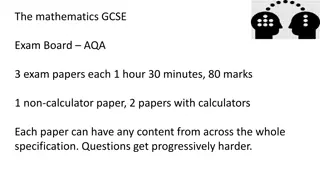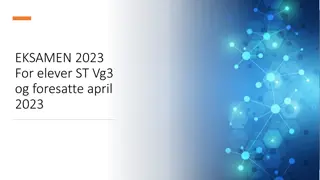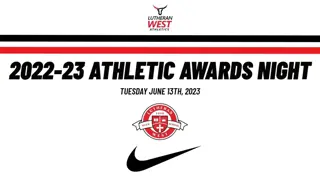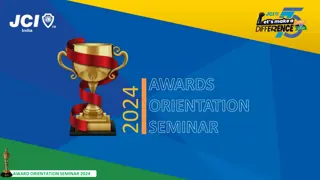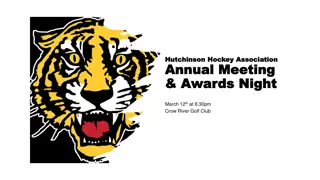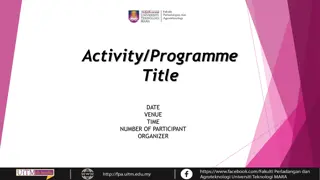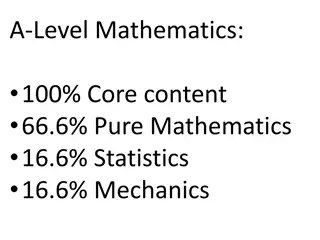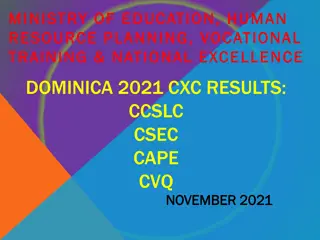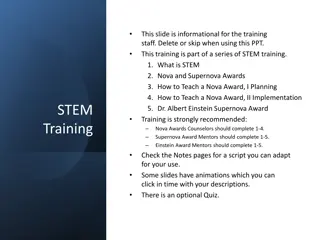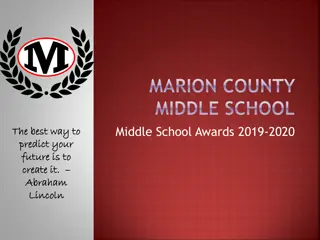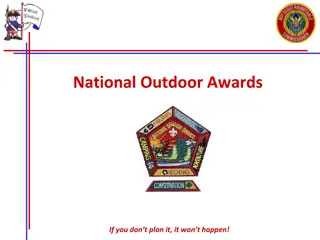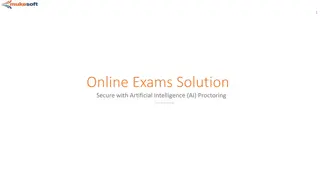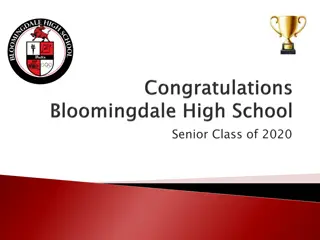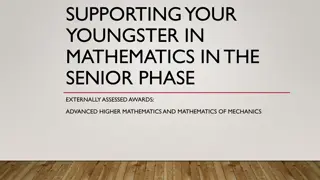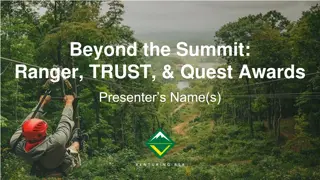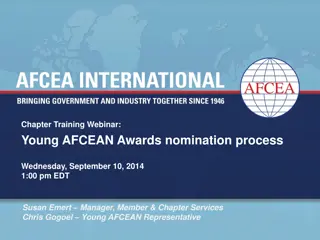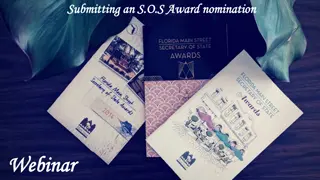Mathematics Achievements and Challenges: Insight into Awards, Exams, and Questions
Delve into the world of mathematics through a detailed exploration of prestigious awards like the Fields Medal, F.R.S. recognition, and the Knighthood of the British Empire. Learn about the historical significance of the Senior Wrangler and the diverse range of topics covered in the Cambridge Mathematical Tripos exams. Challenge your mind with intriguing mathematical questions from past exam papers, showcasing the depth and complexity of mathematical thinking.
Download Presentation

Please find below an Image/Link to download the presentation.
The content on the website is provided AS IS for your information and personal use only. It may not be sold, licensed, or shared on other websites without obtaining consent from the author.If you encounter any issues during the download, it is possible that the publisher has removed the file from their server.
You are allowed to download the files provided on this website for personal or commercial use, subject to the condition that they are used lawfully. All files are the property of their respective owners.
The content on the website is provided AS IS for your information and personal use only. It may not be sold, licensed, or shared on other websites without obtaining consent from the author.
E N D
Presentation Transcript
The Great Mathematician Philippa Fawcett 1868-1948 Dennis Connolly, University of Lethbridge
Awards in Mathematics Fields Medal Awarded to 2, 3 or 4 mathematicians (under age 40) every four years, since 1936. Open to men and women. Considered to be the Nobel Prize for Mathematics; (Nobel Prizes are not awarded in Mathematics). F.R.S. (Fellow of the Royal Society) Awarded since Newton s time (~1672). Open to women in 1945. Considered the second highest award after the Nobel Prize. S.W. (Senior Wrangler) The designation given to the winner of the top mark in the Cambridge Mathematical Tripos exams, which were after three years as an undergraduate. Open to women from 1948 onwards. Wrangler Awarded to those who achieve first class honours in Cambridge Mathematics Tripos exams. From 1753 to 1909, Wranglers were ranked: Senior (S.W.), second (2W), third (3W), etc. After 1909 wrangler names were read out and published in alphabetical order (but not ranked, although the Senior Wrangler was only sometimes announced). KBE (Knight of the British Empire) Hugely distinguished well known awards.
Topics Covered by the Tripos Exams (1) Euclid and conics, elementary modern geometry; (2) algebra and trigonometry; (3) analytic geometry and elementary calculus; (4) statics and dynamics; (5) geometric optics and elementary astronomy; (6) hydrostatics, heat and electricity; (7) problem paper on subjects (1) to (6). (8) analytic statics, dynamics of a particle, rigid dynamics, astronomy, hydrostatics, electricity, hydrodynamics; (9) advanced algebra (series, theory of numbers, theory of equations), symbolic operators, advanced analytics of two and three dimensions; (10) analytic and spherical trigonometry, differential equations, definite integrals, plane curves; (11) analytic statics, dynamics, elasticity, hydrodynamics, electricity and magnetism; (12) theory of functions, elliptic functions, harmonic analysis (Bessel s functions, Fourier s functions, etc.); (13) a mixed paper, both pure and applied; (14) problem paper on (8) to (13). Here again, pure and applied mathematics are given equal weight.
1906 Part I Tenth paper, Question 1 If is a semi-convergent series of real terms, prove that the infinite product un 0 (1+un) tends towards a positive limit or towards zero according as is 0 un 0 convergent or divergent. If u0 = u1 = u2 = 0 & when n >1, u2n 1 = 1 1 n+1 1 n+ n, u2n= , n n (1+un) is convergent. 2 are both divergent, but that 0 un show that & un 0 0
Math Tripos Sample Questions 1913 An observer in latitude 50 sees a star set due west behind a low ridge a mile away, which slopes down to the north at an inclination of 30 to the horizontal. Prove that by stepping a yard to his right he will see the star for about 22 seconds longer.
Max Born (Nobel Prize, Physics 1954) making fun of the Tripos Questions On an elastic bridge stands an elephant of negligible mass; on his trunk stands a mosquito of mass m. Calculate the vibrations on the bridge when the elephant moves the mosquito by rotating his trunk.
Famous Cambridge Wranglers 1845 William Thomson 2W, FRS, later known as Lord Kelvin. 1848 Isaac Todhunter SW, FRS, spoke 7 languages, authored many books. 1854 Edward John Routh SW, FRS, born in Quebec, taught 990 Wranglers 1854 James Clerk Maxwell2W, FRS, Hobson s greatest student. 1856 Henry Fawcett 7W, FRS, father of Philippa Fawcett, U.K. Post Master General. 1865 John Strutt SW, FRS, Nobel Prize 1904, later Lord Raleigh. 1868 George Darwin2W, FRS, KBE, famous astronomer, Charles Darwin s son. 1871 John Hopkinson SW, FRS, coached by Routh. 1872 Horace Lamb 2W, FRS, coached by Routh.
Famous Cambridge Wranglers cont. 1877 Donald McAlister SW, MD, KBE, a great linguist (spoke 18 languages). 1878 Ernest William Hobson SW, FRS, coached by Routh. Hobson became Philippa Fawcett smain coach. 1879 Karl Pearson 3W, coached by Routh. A founder of Statistics, taught Philippa Fawcett at London University (one term only). 1880 Joseph John Thomson 2W, FRS, KBE; Nobel prize 1906, physics, coached by Routh, 1881 Andrew R. Forsyth SW, FRS; Charlotte Angas listed above 9W, first year women write Cambridge Math Tripos
Famous Cambridge Wranglers cont. 1884 W. H. Bragg 2W, FRS, KBE, Nobel Prize Physics (1915 with son Lawrence Bragg) 1886 George Hartley Bryan 5W, FRS, Equations for plane construction & supersonic flights (still used today). 1887 Henry Frederick Baker SW, FRS, Great geometer, PhD supervisor to T. G. Room (1923 Wrangler & FRS) 1889 Frank Watson Dyson 2W, FRS, KBE 1890Geoffrey Thomas Bennett SW, FRS Philippa Fawcett above the SW. 1893 Bertrand Russell 7W, FRS, Lord Russell, Nobel prize, famous Philosopher & Mathematician. 1894 Horatio Scott Carslaw 4W, FRSE, 8 Storey Math building named in his honour at Sydney University. 1895 Thomas John l Anson Bromwich SW, FRS, died young from suicide 1895 Edmund Taylor Whittaker 2W, FRS, Whittaker & Watson s famous book A Course on Modern Analysis still being printed today.
Famous Cambridge Wranglers cont. 1898 James Chadwick 5W, FRS, Nobel Prize Physics 1935 1898 Godfrey H. Hardy 4W, FRS, famous text A Course of Pure Mathematics, worked with The Man who knew Infinity : Srinivasa Ramanujan 1903 Clement Vavasor Durell 7W, great textbook writer. 1904 Arthur Eddington SW (2 years), FRS, KBE, worked on General Relativity, child prodigy (counted number of atoms in Sun, at age 5). 1905 John Edenser Littlewood SW, FRS, worked with Hardy & Ramanujan. 1907 George Neville Watson SW, FRS, worked with Littlewood & Ramanujan. 1907 Herbert Westren Turnbull 2W, FRS
Famous Cambridge Wranglers cont. 1907 Charles Galton Darwin 5W, FRS, KGE (Grandson of Charles Darwin). 1909 P. J. Daniell SW, 44 page obituary. 1909 Last year SW officially announced. Alphabetical ordering for all Cambridge graduates from 1910 onwards. 1923 Thomas G. Room Wrangler, FRS, famous geometer, and my professor at Sydney University. 1925 George Polyaabove the SW, famous author How to Solve it . 1928 Donald Coxeter SW, FRS
Famous Cambridge Wranglers cont. 1930 Jacob BrownoskiSW, authored Ascent of Man (Book & 9 hour TV series) 1940 Hermann Bondi SW, FRS, KCB 1948 Women finally allowed to graduate from Cambridge. Philippa Fawcett awarded Cambridge B.A. (age 80). 2013 Arran Fernandez SW age 18 (youngest ever), passed high school math age 5
The Times (London) Saturday June 7, 1890



